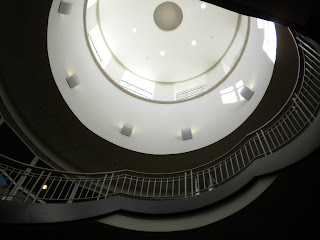Curry
The Curry building has windows that are grouped in pairs, relating to the idea of groves. Columns emulate human forms. The Curry building is also symmetrical which contributes to the idea of balance. Repetition of columns leads to harmony.
Alumni House
The Alumni House has many examples of stacks. The brick facade is an example of stacks as well as the shutters and stairs. The Alumni House also has columns which relate to human forms. There is symmetry in this building as well, giving balance.
Faculty Center
The faculty center also has columns, relating to groves and human forms. We also learned about porticos and the idea of a transitional space- which is a feature of the Faculty Center.
Jackson Library
The tower addition to the back of the Jackson Library is another example of stacking. This could be symbolic of gathering resources, which would be appropriate for a library where many resources are found.
EUC- Back Entrance
EUC-Front Entrance
There were many examples of circles in the EUC. Circles are symbolic of the sun, the moon, and unity. The EUC seems to be a good place for there to be a symbol of unity, since it is a main gathering place for students in the UNCG community. The placement if these circles at both entrances as well as the circle of windows in the ceiling gives an open, airy feeling when you walk in.
A main idea we were to consider was do environments influence rituals or do rituals influence environments. I believe that these elements of circles, groves, and stacks and their surrounding environments influence the rituals that happen within them. An element was put into place based on the function it was intended to serve, for example circles indicating sacred spots.









Great work using design words/principles in your post. Nice use of pictures. I think you could have said a little more. You did well at the end and it would have been nice to see that throughout.
ReplyDelete